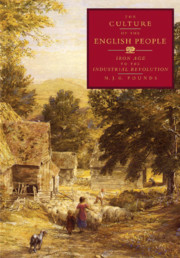Book contents
- Frontmatter
- Contents
- List of illustrations
- List of tables
- Preface
- List of abbreviations
- Map of traditional counties, with abbreviations, as used in this book
- Introduction
- 1 The view from Danebury
- 2 Roman interlude
- 3 House and household
- 4 Heat, light and insecurity
- 5 The house furnished
- 6 Food, its production, preservation and preparation
- 7 In sickness and in death
- 8 The community of parish and village
- 9 The family
- 10 The culture of cities
- 11 The foundations of popular culture
- 12 Conclusion: the end of popular culture
- Notes
- Index
3 - House and household
Published online by Cambridge University Press: 06 July 2010
- Frontmatter
- Contents
- List of illustrations
- List of tables
- Preface
- List of abbreviations
- Map of traditional counties, with abbreviations, as used in this book
- Introduction
- 1 The view from Danebury
- 2 Roman interlude
- 3 House and household
- 4 Heat, light and insecurity
- 5 The house furnished
- 6 Food, its production, preservation and preparation
- 7 In sickness and in death
- 8 The community of parish and village
- 9 The family
- 10 The culture of cities
- 11 The foundations of popular culture
- 12 Conclusion: the end of popular culture
- Notes
- Index
Summary
Methods of construction filtered down in the course of time from one stratum of society to another.
C. F. InnocentThere can have been few occasions in the course of recorded history when physical standards of well-being fell as sharply and as profoundly as they did after the legions had been withdrawn from Britain. But it may be questioned whether this was equally true of all levels of society. It is possible that the end of Roman rule was as little marked on the western and northern fringes of Britain as its establishment had been some four centuries earlier. There is, indeed, good evidence to suppose that the material culture of the late pre-Roman Iron Age continued with little significant change, not only through the centuries of Roman rule but also into those of the Anglo-Saxon conquest which followed. In cultural terms, the end of Roman rule was marked by the elimination of the upper strata of late Roman society. Villas were abandoned because the economic structure which had supported them had disintegrated. Towns ceased to be centres of urban life because their crafts and trade were no longer needed by a society increasingly rural and self-sufficient and because the machinery of government, which had centred in them, had disappeared. In Britain, there ceased, in any cultural sense, to be an élite. Material standards fell. It was not that villas and public buildings were no longer built; those that already existed were not even maintained in usable condition.
- Type
- Chapter
- Information
- The Culture of the English PeopleIron Age to the Industrial Revolution, pp. 64 - 108Publisher: Cambridge University PressPrint publication year: 1994



